The chakras remain a bit of mystery even to the most experienced of yogis. We talk about them a lot in our yoga bubbles, but oftentimes, we’re simply repeating what we’ve heard from somebody else.
We tend to attribute our ‘high’ after a yoga class to the endorphins we all experience after a good workout, but this assumption, while reasonable, might be a little off base.
Could it be that what we’re really experiencing is rejuvenation and cleansing to our energetic bodies instead?
The simple answer is yes. But let’s go a little deeper.
What are Chakras?
The word chakra comes from Sanskrit and directly translates to ‘wheel’ or ‘disk’. The chakras are wheels of energy throughout our bodies. They make up what is called our subtle body.
While in mainstream yoga we primarily hear about the seven chakras, there are actually 114 of these wheels of energy throughout the body. Chakras are made up of nadis. In Sanskrit, nadi translates to ‘flow’ or ‘motion’ and are comprised of prana, meaning energy or life force.
We have roughly 72,000 of these energy channels in our subtle body. And when three nadis meet in the body, they form a triangle and this triangle makes up a chakra.
Some of our chakras are very strong and affect us powerfully, while others are not as influential. But there are seven chakras that dominate the subtle body energetically; each of these is made up of prana that can be open or closed, flowing or blocked.
To find where these chakras are in your body, imagine you’re in a seated position such as Sukhasana (Easy Pose). Then picture seven wheels of light in a line at the base of your spine through the crown of your head. These are the seven chakras we’ll be focusing on for your yoga practice.
The chakras affect all aspects of life: mental, spiritual, physical.
When our chakras become unaligned—one is closed while others are open—the energy in our subtle body becomes imbalanced and can lead to illness. On the same note, when our chakras are too open, then they too fall out of balance.
Each chakra is unique in its energy and how it attributes to spiritual, mental and even physical bodies.
Our chakras correspond with nerve centers in our body, as well as with our major organs. The chakras are also directly correlated with our mental and spiritual health. This is why it’s so important to keep our chakras aligned with one another.
The Seven Chakras
- Muladhara Chakra (Root Chakra)
- Svadhisthana Chakra (Sacral Chakra)
- Manipura Chakra (Solar Plexus Chakra)
- Anahata Chakra (Heart Chakra)
- Vishudda Chakra (Throat Chakra)
- Ajna Chakra (Third-Eye Chakra)
- Sahaswara Chakra (Crown Chakra)
Of the seven chakras we’ll be focusing on right now, there are three chakras of matter, three chakras of spirit, and one bridge between the two. Let’s dive in.
Muladhara Chakra (Root Chakra)
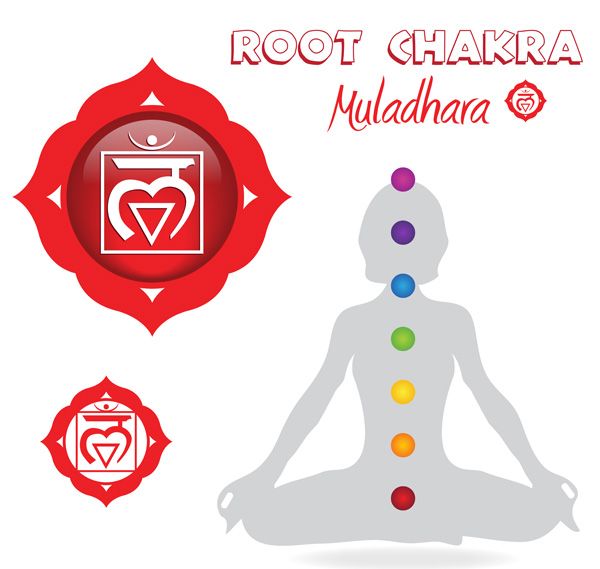
Color: Red
Sound: LAM
Element: Earth
The Muladhara Chakra, known as the Root Chakra, is located at the pelvic floor and the base of the spine. ‘Mula’ means ‘root’ and ‘adhara’ means ‘base’ or ‘foundation’ in Sanskrit.
The Muladhara Chakra is the first chakra of matter. It is the foundation of everything we do. Just like the foundation of a house, if it’s not strong, the rest of our body crumbles along with it. If it becomes blocked, we can fall ill or feel imbalanced and insecure in our lives.
Our Root Chakra is connected to the things that make us feel secure and stable.
Our basic human needs—eating, sleeping, drinking water, feelings of safety—all affect the stability of the Muladhara Chakra. When these needs are met, we are more likely to feel safe and secure in our lives.
This directly correlates with our childhood as well. If you didn’t receive love freely as a child, or your caregivers simply didn’t give you what you needed, you’re more likely to experience imbalance in your Root Chakra.
An imbalanced or blocked Muladhara Chakra can result in anxiety, depression, fear or insecurity. There are also physical ailments that can result as well such as lower back pain, bladder infections and colon problems.
Fortunately, there are many ways to balance the Root Chakra, one of which is through yoga asanas (poses). Asanas can easily stimulate the Muladhara Chakra and release any negative energy that has built up over time.
Before you practice any of these poses, make sure your body is properly warmed up by doing a few Surya Namaskars (Sun Salutations) or try out this warm-up sequence.
Yoga Poses for Muladhara Chakra (Root Chakra)
When practicing yoga for the Root Chakra, you want to find poses that ground you yet make you feel free simultaneously. Each of these poses will help you do just that, while stimulating Muladhara and helping to let go of any blockages that may have occurred there.
Tadasana (Mountain Pose)
Standing at the top of your mat, ground down through the soles of your feet. Roll your shoulder blades back, opening through the upper body. Close your eyes.
If you want a little more earthly connection, try doing these poses outside on grass, dirt or sand.
Supported Malasana (Squat Pose or Garland Pose)
Use a block or bolster to support your hips and buttocks in this deep squat. Bring your hands to your heart and close your eyes.
See how this pose calms your mind by bringing you close to the earth. Bring your attention to your feet and ground down through your soles to intensify the feeling of being supported.
Balasana (Child’s Pose)
Let your body melt into this pose and focus your attention on what it feels like to be completely supported by the earth. Rest your forehead to the mat and notice the balance of surrender and support that Child’s Pose inspires.
Setu Bandha Sarvangasana (Bridge Pose)
Bridge Pose helps you ground through your feet while pressing your Muladhara Chakra up to the sky, stimulating and energizing it. This opens up the spine, which will warm up your body for opening and balancing the rest of the chakras.
Sukhasana (Easy Pose)
Close your eyes. Feel into the part of your body that is touching the earth and begin to deepen your breath.
Notice how, as you begin to breathe deeply, the energy from your lower body starts to pull closer to the earth, while your upper body softens.
Stay here in meditation for five to ten minutes.
Svadhisthana Chakra (Sacral Chakra)
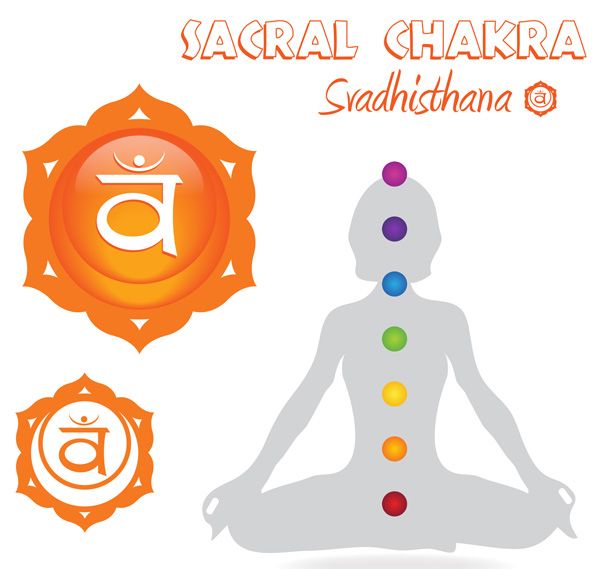
Color: Orange
Sound: VAM
Element: Water
Our Sacral Chakra is located just above the pubic bone and below the navel. It houses our creativity, sensuality, money, career, fear of abandonment, relationships, pleasure and addictions. It is the second chakra of matter.
It is natural for us as humans to create—not only as in procreation, i.e. making babies—but art, ideas, cooking, gardening or anything else that stimulates our creative muscles. Our Svadhisthana Chakra is directly correlated to this creativity.
Many adults have a hard time keeping the Sacral Chakra open and flowing due to lack of inspiration. As kids, we were encouraged to draw, paint and play, but somewhere along the way, those behaviors were deemed ‘childish’ and we forgot how to channel our own individual creativity.
We’re taught to follow the rules: go to school, get a degree, get a job and retire. And there’s nothing wrong with that if it’s what you really want to be doing, but when it’s not and we do it anyway, that’s when we create blockages in energy.
When we allow ourselves to create lives that align with our individual truths, our Sacral Chakra opens and lines up with the rest of our energetic body.
Physically, the Sacral Chakra is linked to our sexual organs, lower back, hips, bladder, pelvis, kidneys and large intestine.
When the Svadhisthana Chakra is out of balance you may feel discomfort in these areas of your body. For example, financial security and money-related issues are often linked with lower back pain.
Our emotions also directly reflect our physical state—any pain or feelings that we resist don’t simply go away, they store themselves in our physical body until they’re dealt with (felt deeply), and only then can they be released.
Yoga Poses for Svadhisthana Chakra (Sacral Chakra)
There are many asanas for opening up the sacral chakra and releasing negative energy. These poses create space for you to open the sacral area and feel emotions that have been stored there.
Deep hip openers and fiery poses that strengthen the muscles around the hips and buttocks are perfect for opening up the Svadhisthana Chakra.
Seated Pelvic Circles
Sitting in Easy Pose, place your hands on your knees. Close your eyes and begin to make circles with your upper body, moving in one direction several times before switching to the other direction.
This is a great way to stimulate the Sacral Chakra and help you turn your focus to that specific area of the body. Treat pelvic circles as a meditation and/or a warm-up for the rest of your practice.
Baddha Virabhadrasana (Humble Warrior)
The warrior poses are great ways to heat up your body and begin to open the hips.
Humble Warrior is especially good for opening up the Sacral Chakra because it strengthens the muscles around the hips and lower core while creating a deeper opening throughout this area.
Mandukasana (Frog Pose)
One of the most intense hip openers, Frog Pose is great for releasing tension in the hips and alleviating lower back pain.
This pose can be very intense.
Because we store a lot of emotions in our hips, feelings we’ve been ignoring will likely make themselves known while in this pose. See if you can stay and sit with yourself as these feelings arise—this is where healing begins.
Utkata Konasana (Goddess Pose)
Another fiery hip opener, Goddess Pose will ignite your creative fires and make you feel alive.
Have fun with this pose—play with arm variations, add in some core exercises or play some of your favorite music and set yourself free.
Eka Pada Rajakapotasana (One-Legged Pigeon Pose)
The perfect way to round out your practice, Pigeon Pose opens up the outer hips.
Similar to Frog Pose, you may find that a lot of feelings come up for you during this asana. This can be uncomfortable but staying with yourself in these moments is exactly what your body, physical and subtle, needs to realign and heal itself.
Manipura Chakra (Solar Plexus Chakra)
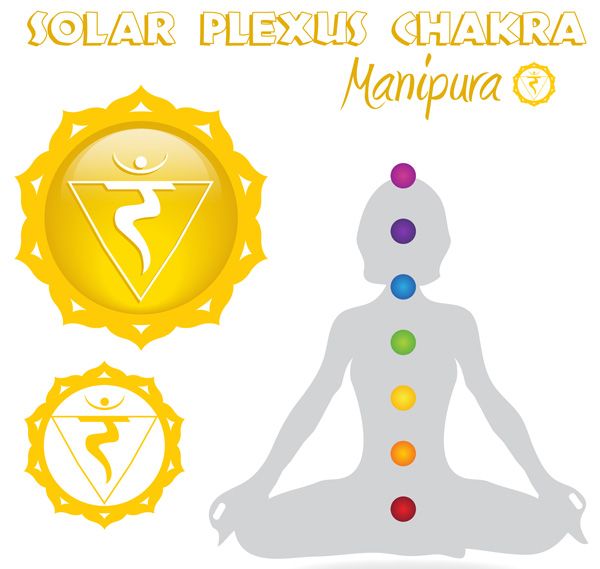
Color: Yellow
Sound: RAM
Element: Fire
The final chakra of matter, the Manipura Chakra is located from the navel up to the breastbone; this area is called the solar plexus. Manipura translates from Sanskrit into ‘lustrous gem’.
Our Solar Plexus Chakra is linked to our self-esteem, worth, inner power and energy. Physically, it affects our digestive system, stomach, liver, gall bladder, spleen and mid-back (spine).
When our Solar Plexus Chakra is open and aligned with the rest of our chakras, we feel confident, full of energy and empowered to make decisions that resonate with the lives we want to be living.
But when the third chakra becomes blocked, we struggle with decision-making, our self-esteem diminishes and we begin to feel stuck.
Our digestion is one of the best physical ways to know the state of our third chakra. When our digestive fires (agni) cease to burn, we become constipated, both physically and spiritually.
Our gut instincts live in our Manipura Chakra, so keeping it open is essential in our ability to make smart decisions and living honestly.
Yoga Poses for Manipura Chakra (Solar Plexus Chakra)
To rev up the Manipura Chakra, opt for poses that create strength in your core. These asanas will stoke your inner fire and give you new energy so you can live from your core power in all areas of your life.
If you feel like you have too much energy in your solar plexus, go for more cooling poses like twists or backbends.
Paripurna Navasana (Boat Pose)
As you strengthen your core, your confidence will strengthen along with it. Boat Pose is a great abdominal workout. When we strengthen this area of the body, we reenergize our major organs, giving us more energy to live powerfully.
This is will also help speed up the digestive system, relieving us of any feelings of being stuck in our lives.
Ardha Matsyendrasana (Half Lord of the Fishes Pose/Seated Spinal Twist)
This pose will stimulate the solar plexus area from front to back. It aids in digestion, relieves back pain and creates an opening throughout.
Do this pose when you feel like your Manipura Chakra is in overdrive to calm your nerves and come back to your true intentions.
Dhanurasana (Bow Pose)
Bow Pose is a great backbend with cooling effects on the Solar Plexus Chakra. It also aids in digestion, but the special thing about Bow is that it stimulates the liver, as well.
Bow will help you create space for more of the good things in life: more confidence, exciting ideas and unwavering self-esteem. Just make sure you warm up a little bit before bending backward—especially in your shoulders, spine and hips.
Phalakasana (Plank Pose)
It’s no secret that plank pose is a great core strengthener—ten seconds here and you might be asking to leave. But that’s why it’s perfect for our Manipura Chakra.
Stay in a plank a little longer and see how quickly it heats up your core and leaves you feeling like you can take on anything!
Surya Namaskar (Sun Salutations)
Sun Salutations are the perfect warm-up for your yoga practice. A great way to create heat in your whole body, Sun Salutations will fire up your core in a dynamic way.
With each transition, see if you can activate your core and move from there, from your center. You’ll not only feel a change in your body, but you’ll come out of it feeling empowered and in control of your life.
Anahata Chakra (Heart Chakra)
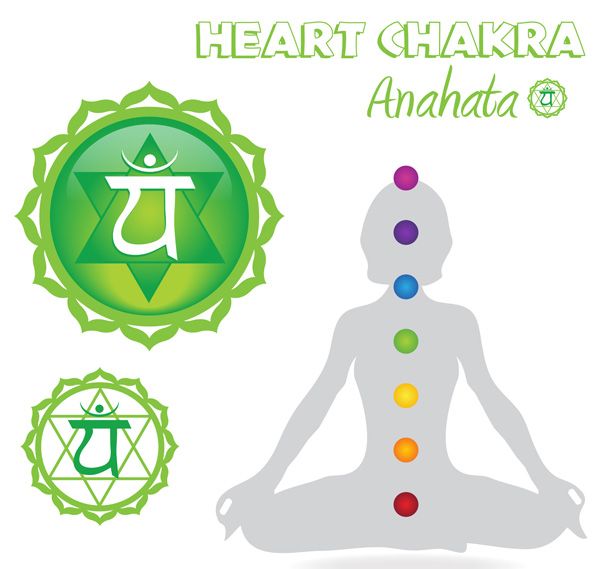
Color: Green
Sound: YUM
Element: Air
Anahata translates from Sanskrit to ‘unhurt’. The Anahata Chakra is the bridge between the chakras of matter and the chakras of spirituality.
It is located in and around the heart and includes the lungs, breasts, thymus gland, diaphragm, ribs and shoulders all the way through the arms and hands.
The Heart Chakra represents compassion, unconditional love and forgiveness. When it is open, we are flowing with kindness, selflessness, acceptance and unity. A closed Anahata Chakra results in jealousy, fear and anger.
We store past traumas in our heart center, and like the Sacral Chakra, these experiences become stored here unless we feel into them deeply, before they can be released.
The translation, ‘unhurt’ is symbolic of what is beneath the experiences that have scarred us. It implies there is a place within us that is unscathed, unbroken and pure; a place where pain doesn’t exist.
We all go through hardships in our lives—there’s no avoiding it. But it’s our choice in what we do with those hardships. We can choose to ignore them or block them out, in which case we’ll end up angry and hardened.
Or, we can choose to sit with them and nurture them, allowing them to release themselves only when they’ve been thoroughly felt. Doing so releases negativity and opens up our Heart Chakra.
Opening up here creates empathy and compassion. Let’s take a look at a few yoga poses that will help us do just that.
Yoga Poses for Anahata Chakra (Heart Chakra)
When you’re working to balance energy in your Heart Chakra, choose poses the open up the front or back of the chest and shoulders.
Anahata Chakra longs to be released, especially if you’re someone who tends to hold on to things for too long, or holds grudges. Backbends will help you learn to trust yourself and give you the surrender needed to release these negative feelings.
If you have too much Heart Chakra energy—you feel as if you’re giving too much of yourself away—opt for chest openers that have a little more fire like balancing poses or standing heart openers.
Ustrasana (Camel Pose)
This deep backbend is one that many of us tend to shy away from. Maybe one of the most vulnerable poses in yoga, Camel Pose challenges us to open in a way we rarely do in everyday life, especially in a public space.
If you often feel nauseous while practicing Camel, that’s completely normal. Having your entire front body exposed—neck, heart, core and pelvic area—is not something that’s easy or feels natural to us. But that’s why this pose is so perfect for balancing the Anahata Chakra.
If you can relate to this, move slowly. You don’t have to take full Camel right from the beginning. Start by placing your hands on your lower back, take a deep breath in and look up to the sky.
Once that feels okay, you can start deepening the pose. Be gentle and don’t put too much pressure on yourself to dive in right away. Also, do make sure to warm up your spine before practicing Camel.
Garudasana (Eagle Pose)
A great balancing pose for those who feel like they want to cool the energy of the Heart Chakra, Eagle Pose opens the back of the chest, while bringing strength to our shoulders—encouraging us to soften and strengthen simultaneously.
Marjaiasana/Bitilasana (Cat/Cow Pose)
Adding a few rounds of Cat/Cow at the beginning of your practice is a great way to open up the front and back of the chest passively. See if you can lead with your heart, opening and closing it with each breath.
Cat/Cow is perfect not only for opening the chest and shoulders, but for creating a nice balance in our Heart Chakra.
The complementary movements open both sides of the body equally, making it the perfect option for anybody who feels a little off, but isn’t sure of exactly what it is they need.
Virabhadrasana I (Warrior I Pose)
Another pose that encourages softening and strengthening at the same time, Warrior 1 will help you ground down through your Root Chakra, while opening your heart.
If we don’t allow ourselves to get grounded before deeply opening our hearts, we get too much energy flowing in our Heart Chakra, and we become too vulnerable and easily manipulated.
Anytime you’re feeling like you need to lovingly come back to yourself, include Warrior 1 into your practice. Feel the grounding energy pulling you from your feet and the deep opening in your chest creating space in your heart, just for you.
Matsyasana (Fish Pose)
Whether you practice Fish Pose supported with a block or not, this is a great place to find opening in your heart, while restoring your body.
The heart is positioned higher than the head here, as it is in many backbends, which brings joy to our practice and gives us the strength to overcome our fears of vulnerability and surrender.
Vishuddha Chakra (Throat Chakra)
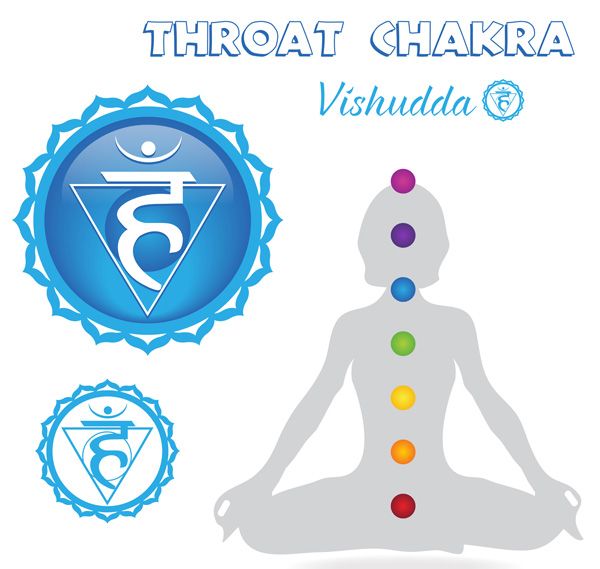
Color: Blue
Sound: HUM
Element: Ether, Space
Vishudda Chakra is the first of the spiritual chakras. It is associated with self-expression, listening, communication and understanding.
When the Throat Chakra is aligned, we are able to communicate our truths clearly and confidently.
This is not an easy task for a lot of us, but as we work on clearing our lower chakras of negativity and aligning them with one another, we’re better able to stand in our truth and speak freely.
Vishuddha Chakra affects our throat, thyroid, mouth, jaw and neck. Repeated throat infections like strep throat or sore throat may mean you’re holding back and not expressing your feelings openly.
When we stop speaking honestly because we’re afraid of being disliked or hurting someone else’s feelings, the energy in our Throat Chakra becomes blocked.
Affirmations can be very helpful in teaching us to speak truthfully, especially when they relate directly to our lives. As we repeat positive affirmations to ourselves or out loud, we become more comfortable with speaking in the same way with others.
And while speaking our truth ultimately has to come from us, there are a few yoga poses that might help you open up your Throat Chakra and give you the confidence to speak up.
Yoga Poses for Vishuddha Chakra (Throat Chakra)
In opening up and balancing the Throat Chakra, you want to find poses that open up the throat and neck.
A lot of us hold tension in our neck, which might be due to lack of or too much energy in our Vishuddha Chakra. These poses will help bring balance to this area, aiding in clear communication and space for individual creativity.
Neck Stretch
Come to a comfortable seated position, sitting up tall. Start by bringing your right ear to your right shoulder for one breath. Come back to center and repeat on the left side. Do this five to ten times.
Then look left and right over each shoulder. Only go to your stopping point; there’s no need to strain your neck by trying to look behind you.
Finally, look up to the sky and then down to the floor, bring your chin to your chest.
Sasakasana (Rabbit Pose)
Rabbit Pose gently opens up the back of the neck, releasing any built-up tension. It also has a calming effect with the heart above the head, allowing us to ease more gently into this sensitive area.
Bhujangasana (Cobra Pose)
Cobra Pose challenges us to open the front of our neck and throat. It also creates strength in the back of the neck, perfect for giving more energy to the Throat Chakra.
Sarvangasana (Shoulderstand)
This inversion is perfect for energizing the Throat Chakra. With our hips and feet above the head and heart, Shoulderstand sends freshly oxygenated blood to our throat.
It also opens up the back of the neck, creating space and balancing the Throat Chakra.
Halasana (Plow Pose)
From Shoulderstand, move into Plow Pose. Great for anyone with deficient energy in their Vishuddha Chakra, Plow provides another deep opening for the back of the neck.
Ajna Chakra (Third Eye Chakra)
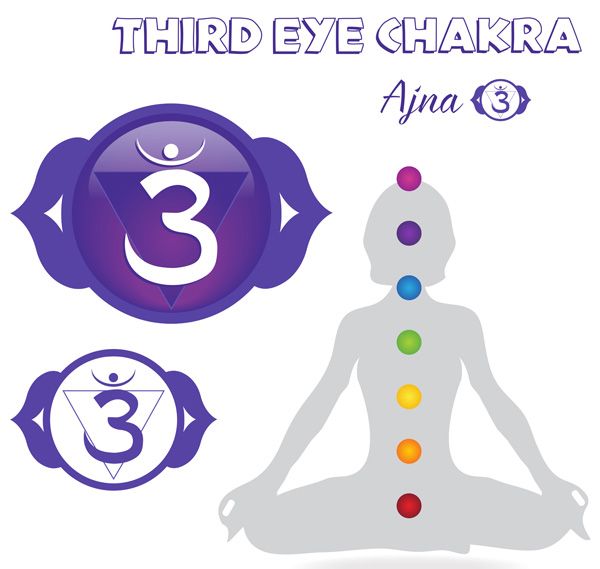
Color: Indigo
Sound: SHAM
Element: Light
Ajna, meaning ‘beyond wisdom’ in Sanskrit, is the second spiritual chakra. It is located in between and just above the eyebrows.
We experience our lives through our five senses: sight, hearing, touch, taste and smell. However, we have a sixth sense—our intuition. And our intuition is housed within our Third Eye Chakra.
While our third eye is invisible to our human eyes, it is capable of being very strong—that is, as long as we keep our Ajna Chakra open and balanced.
Have you ever just had a feeling about a situation? Maybe something felt a little off, but logistically everything was seemingly fine. And then, you later found out the person you were dealing with or the situation you were in, actually turned out to be negative. Well, that was your intuition helping you out.
When our sixth chakra is balanced, we’re able to act on our gut instincts more easily, we trust ourselves more and we take our inner self into account when it comes to decision-making, rather than relying solely on reason.
Physically, our Third Eye Chakra connects with our eyes, pituitary gland, lower brain and head.
When we’re in alignment, we have an expanded imagination, higher wisdom and a deeper connection the self.
But when our Third Eye Chakra becomes unbalanced, we experience nightmares, headaches, difficulty concentrating and even hallucinations. We may also have a hard time remembering simple things and experience eye problems.
If you feel like you need to clear out your third eye and tune in to your intuition, try these five yoga poses below.
Yoga Poses for Ajna Chakra (Third Eye Chakra)
The Third Eye Chakra is best balanced through meditation, but there are several yoga poses that will help bring you back in touch with your intuitive self. Poses that invert the head, or touch the forehead to the earth or mat are good ways to light up that sixth sense.
Also, poses where it’s difficult to see your body and you have to rely more on feeling than seeing are helpful in reigniting the intuitive senses.
Meditation
When we have too much energy in our Third Eye Chakra, our minds start buzzing and we feel like we can’t focus on anything.
Practicing daily meditation, even if only for ten minutes, will help calm the mind and balance all of our senses.
Virabhadrasana III (Warrior III Pose)
Warrior 3 is good for the third eye because we’re forced to rely on how the pose feels rather than how it looks. Because we can’t see ourselves well in this pose, it becomes more about feeling.
We have to bring our awareness into our bodies and feel our way through. This connection and feeling relationship helps restore balance and calm in our Third Eye Chakra.
Ardha Pincha Mayurasana (Dolphin Pose)
This forearm version of Downward-Facing Dog is a great way to get some new blood flowing through our third eye.
Try this variation: with your forearms on the mat, hips pressing up and back, bring your hands into prayer with the pinky-finger-side of the hand on the mat. Press your thumbs into your third eye center.
This will generate energy and focus to this specific area. Keep your attention on your third eye while you breathe through this pose.
Parsvottanasana (Pyramid Pose/Intense Side Stretch Pose)
Pyramid is another good way to energize the third eye. See if you can touch your forehead to your knee, bringing attention and awareness to the third eye center, the same way you did in Dolphin Pose.
Pincha Mayurasana (Feathered Peacock Pose)
Another inversion, Feathered Peacock Pose stimulates the third eye by bringing it completely upside down.
For added stimulation, bring your hands to prayer the same way you did in Dolphin Pose, and touch your thumbs to your third eye. Focus, stay, breathe.
Sahasrara Chakra (Crown Chakra)
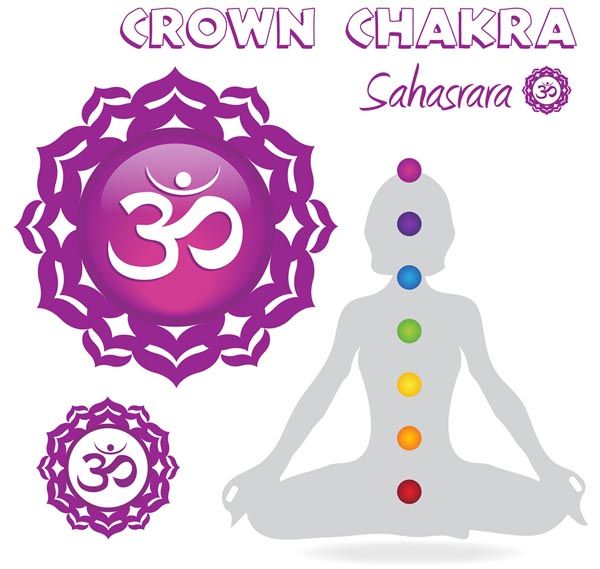
Color: Violet, White
Sound: OM
Element: Thought
The final chakra, and the third spiritual one, is the Sahaswara Chakra, or Crown Chakra. Sanskrit for ‘thousandfold,’ the Crown Chakra is located physically at the top, or crown of the head.
Its true meaning remains spiritual. It is connected to enlightenment, higher knowing and intuitive wisdom. The symbol for the Crown Chakra is a lotus flower with a thousand petals.
Just like the lotus flower which blooms in a muddy and less than ideal environment, we too can reach a state of enlightenment, regardless of the glamour or lack thereof in our lives.
When we are aligned with our Crown Chakra, we feel connected—to ourselves and to every living thing on the planet. We surpass our egos and the physical body, and gain a new perspective on life and the world around us.
We gain a sense of purpose and a connection to a higher power.
However, when our Crown Chakra falls out of balance, we lose that sense of purpose. Indifference and depression creep in and we become attached to material things, as well as losing hold of our morals and ethics.
To help bring your Crown Chakra back into balance, quiet your mind with these yoga poses below.
Yoga Poses for Sahaswara Chakra (Crown Chakra)
Like the Third Eye Chakra, meditation is the best practice to balance the Crown Chakra. Meditation helps us focus on the moment, clearing our minds of worries and anxieties about the past and future.
However, there are some yoga poses that can help balance and wake up the Crown Chakra. Balancing the Crown Chakra means balancing all aspects of ourselves: masculine and feminine, light and dark, right and left.
These poses will help you find that balance and alignment in the Sahaswara Chakra, as well as in the other six chakras.
Padmasana (Lotus Pose)
Lotus Pose is ideal for a seated meditation practice. It helps calm the body, ease anxiety and balance the Crown Chakra.
If Lotus doesn’t work for your body, start by coming into Ardha Padmasana (Half-Lotus Pose) and slowly work your way toward full Lotus.
Adho Mukha Svanasana (Downward-Facing Dog)
Down Dog is a great pose to find balance throughout the entire body. In it, we physically find balance between our hands and feet, and right and left sides.
Let your head hang heavy in the pose, allowing the blood to rush to your brain and take a few moments to notice the weight in your feet and hands. See how you can shift forward and back and how that affects the way the pose feels in your body.
Sirsasana (Headstand)
This inversion is great for the Crown Chakra because we’re balancing right on top of it. It stimulates the energy in the crown of our heads and helps us find stability throughout our entire bodies.
Natarajasana (Lord of the Dance/Dancer Pose)
In order to stay upright in Dancer Pose, you have to find a balance between your upper body and your lifted leg. If your upper body leans too far forward, you fall, and if you kick too deeply into your hand, you fall.
Use Dancer Pose to find balance and harmony between your upper and lower chakras and liberate your Crown Chakra.
Savasana (Corpse Pose)
Finally, lie down on your back and come to Savasana. Arguably the most important pose, Savasana combines meditation and relaxation.
The perfect pose to end your practice with, your thoughts can come to a rest and your body can melt into the mat.
In balancing the chakras, we must focus on all of them. If we give all our attention to just one or two, the others lose balance as well.
It’s okay to spend a little more time on the one or two that are more imbalanced than the others, but be sure to include the other chakras into your practice so you can stay balanced, aligned and connected throughout your entire body.
The Bottom Line
Practicing Chakras Yoga through asanas offers a transformative journey towards balancing and harmonizing the energetic body. By engaging in specific poses that target each chakra, we can unlock and unleash our inner potential, leading to enhanced physical, emotional, and spiritual well-being. Join our Chakras Yoga course “Understanding Chakras” today to embark on this enlightening path and cultivate a deeper connection with yourself and the world around you.

Responses